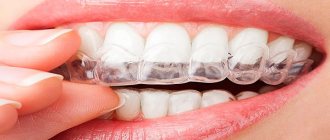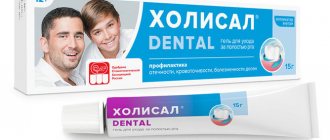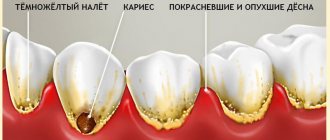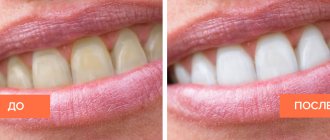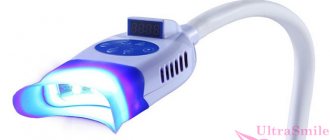From this article you will learn:
- how to whiten teeth at home without harm,
- professional home whitening systems,
- What are the dangers of bleaching with activated carbon, soda or hydrogen peroxide.
The article was written by a dentist with more than 19 years of experience.
In some cases, teeth whitening at home can be no less effective than at the dentist's office. The most effective way to do this is with special home whitening kits, consisting of whitening gel and dental trays. The second most effective remedy is probably the use of certain types of whitening strips.
It must be admitted that most patients do not like to go to doctors, and therefore they are much more comfortable doing teeth whitening at home than going to the dentist. In addition, the cost of a home whitening course will average about 4,000 rubles, which is significantly cheaper than professional whitening techniques such as Zoom®, the cost of which starts from 15,000 rubles.
How to whiten your teeth at home quickly and effectively - this can be done using Opalescense kits or Crest 3D White whitening strips:
How effective is home whitening?
The best at-home whitening products will lighten your teeth by about 4-6 shades (on the Vita Teeth Shade Chart), but will require daily use for 10-20 days. Whitening at the dentist most often provides a similar result, but the procedure will only last 1 hour. But the best whitening pencil or toothpaste can change the color of your teeth by only 1-2 shades.
You can evaluate for yourself how effective home teeth whitening will be. A noticeable result of 4-6 tones can be obtained only if your teeth initially have a yellow tint. Here you can really notice the before and after difference. But if you want to make already quite light teeth whiter, the whitening effect is unlikely to be more than 1-2 tones (and not only after home remedies, but even professional whitening).
Only teeth with a yellowish tint respond well to whitening. If your teeth have a gray or brown tint, whitening (both at home and professional) will be an ineffective procedure.
Why do teeth turn yellow and darker?
The hard tissues of the tooth consist of two layers - translucent enamel and underlying darker dentin. Over the course of life, the enamel on the teeth becomes thinner, which causes the darker layer of dentin to increasingly affect the overall color of the teeth. It is also important that dentin itself (with age) tends to become darker, thereby changing the optical properties of teeth.
Secondly, personal habits regarding the consumption of various foods and drinks are of great importance -
- tobacco use,
- black tea and coffee,
- red and white wine,
- carbonated drinks,
- berries and other foods rich in dyes,
- sauces (soy, tomato, curry).
Thirdly, teeth acquire a duller, grayer shade as a result of their depulpation (removal of the nerve and subsequent filling of the canals). Fourthly, after filling the root canals, the tooth may acquire a bluish color, which occurs as a result of mistakes and negligence of the dentist, if at the time of introducing filling materials into the root canals, traces of blood remain on their walls.
Diet after whitening
In order to admire your snow-white smile for as long as possible after whitening, you need to adhere to a special “white” diet. Its main goal is to exclude from the diet those foods that contain food dyes. They can negatively affect the shade of the enamel.
So, what should you not eat the first two to three days after teeth whitening:
- strong tea, coffee
- red wine, berry fruit drinks
- colored carbonated drinks
- intensely colored vegetables (beets)
- chocolate, cocoa
- ketchup, sauces, mustard
It is advisable to give up such a bad habit as smoking. This will have a positive effect on the shade of your teeth and your overall health.
Teeth whitening with professional home systems –
We will talk about professional home whitening systems produced by many manufacturers. Effective products for teeth whitening at home contain exactly the same active substances that are used in professional whitening techniques (only in lower concentrations). The most effective is chemical teeth whitening using carbamide peroxide.
These peroxide compounds, with prolonged contact with the surface of the teeth, are able to penetrate the entire depth of enamel and dentin, where they disintegrate with the release of free radicals - atomic oxygen (Fig. 4). It is free radicals that destroy the molecules of chromogenic substances that impart pigmentation to the hard tissues of the teeth, as a result of which the teeth become lighter.
Hydrogen peroxide and carbamide peroxide are used in the form of gels. In whitening strips, this gel is already applied to their inner surface, and therefore, when applying the strips, the gel will come into contact with the front surface of the teeth. In Opalescense home whitening kits, the gel is applied to the inside of special dental trays, which are placed on the teeth for a certain period of time.
Important : to whiten your teeth effectively at home, you must first clean your teeth of pigment plaque and hard dental deposits (if any). And for this you still have to visit a dental hygienist. The fact is that a layer of pigment and microbial plaque will prevent the penetration of the active components of the whitening gel into the hard tissues of the teeth.
Accordingly, the gel will have difficulty affecting areas of tooth enamel covered with pigment plaque, and will have a good effect where there is no pigment plaque. This may result in uneven shade (mottled teeth). As we said above, you can try to predict the result of home whitening, which, when using the highest quality products, can be expressed in a change in teeth color by 4-6 tones according to the Vita tooth shade scale (Fig. 5).
Teeth shade scale “Vita” –
Brushing teeth with peroxide and whitening recipes
Brushing your teeth with regular hydrogen peroxide is one of the most effective dental whitening techniques. During normal rinsing, the active substance may not reach some areas of the crowns, which can lead to their spotty coloring, but when cleaning, such a defect is eliminated. When using a brush, peroxide penetrates into the deeper layers of enamel, as well as into hard-to-reach interdental areas, providing faster and better whitening.
To prepare a cleaning solution, you need to take peroxide and water in a 1:1 ratio and mix. The prepared mixture should be used instead of a regular paste twice a day, and after each procedure you should rinse your mouth thoroughly with water.
You can brush your teeth with non-concentrated hydrogen peroxide only for a week, then you should switch to regular toothpaste.
After whitening, it is necessary to use remineralizing gels:
- Blend-a-med;
- OCS;
- Elmex;
- Global White.
Whitening enamel with peroxide and soda
You can whiten your teeth at home using pharmacy hydrogen peroxide and baking soda. The combination of such substances provides the most effective whitening, since soda quickly lightens crowns, and peroxide consolidates the result.
You need to combine baking soda and hydrogen peroxide in equal proportions, mix the components and apply the mixture to the dental surface. You should avoid getting substances on your gums, and in case of accidental contact, rinse your mouth well with water or chamomile decoction.
Apply the mixture to your teeth with a cotton swab or fingertips. It is not recommended to use a brush, as this will be too aggressive on the enamel and will minimize the possible benefits of baking soda and peroxide.
Photo: teeth before and after whitening with soda and peroxide
Recipe for lightening powder made from baking soda, lemon and hydrogen peroxide
Another effective composition for lightening enamel is a solution of soda, hydrogen peroxide and lemon juice. When the components are mixed, a powder is obtained that is used to clean teeth. You need to take the ingredients in the following proportions:
- ½ tsp. soda;
- 20 drops of peroxide;
- 15 drops of juice.
Clean crowns with lemon soda using your finger or a soft bristled brush. It is recommended to treat tooth enamel with it 1-2 times a week for a month, but if any side effects occur (pain, bleeding gums), the lightening course should be interrupted.
After each treatment of enamel with a lemon-soda mixture, it is recommended to use a fluoride-containing toothpaste to clean teeth and rinse the mouth with a herbal infusion.
A high-quality lightening effect after using the lemon-soda composition is achieved due to the combined action of its components:
- soda destroys calcined inorganic substances;
- the acid found in lemon juice removes accumulated plaque;
- peroxide brightens cleaned enamel.
Photo: teeth before and after whitening with a mixture of lemon, soda and peroxide
Toothpaste and Baking Soda Lightening Recipe
Another effective way to whiten teeth at home is a mixture of toothpaste and soda. Any paste that a person is used to using is suitable for its preparation.
To prepare the mixture into a paste in an amount that is used for one daily brushing of teeth, you need to add half the amount of soda. For the procedure, it is better to take a brush with soft bristles. A mixture of peroxide and paste should be used 1-2 times a week. To whiten teeth several shades, 4-5 procedures are enough.
Photo: teeth before and after brushing with baking soda paste
Opalescense – teeth whitening with trays
Home teeth whitening with trays from Opalescense is one of the most popular home whitening methods in Europe and the USA. Opalescense whitening kits are produced by a well-known manufacturer of dental materials - the company ULTRADENT (USA), which also produces products for professional whitening at the dentist (i.e. you will get a really high-quality product).
There are 2 options for whitening with the Opalescense system -
- Opalescence PF (from 4500 rubles) –
contains bleaching gel based on carbamide peroxide at a concentration of 10%, 15% or 20%.
You can buy Opalescence PF (Fig. 6) in any of these concentrations. In addition to the active substance, the teeth whitening gel also contains potassium nitrate and sodium fluoride, which are necessary to reduce tooth sensitivity, which often develops due to whitening. Whitening with Opalescence PF is no less effective than professional whitening techniques. However, this particular Opalescence option will require more effort from you. The fact is that Opalescence PF teeth whitening gel is intended for use only in individual trays (Fig. 7-9), for the manufacture of which you will still have to go to the dentist once. Dental trays are reusable, and in the future you can use them for repeated whitening courses.How it is carried out - individual trays with whitening gel added to them are placed on the teeth for the whole night (this is the most convenient option). You can also do this during the daytime. The duration of whitening can be from 1-2 hours to 8-10 hours daily, which will depend on the concentration of carbamide peroxide used, how pronounced the effect you want to achieve, as well as on the degree of tooth sensitivity. The whitening process is as follows:
Kit Contents - The kit includes 8 syringes of 10, 15 or 20% carbamide peroxide whitening gel, 1 tray storage container, Opalescence toothpaste, travel bag case, and a tooth shade guide so you can keep track of change in tooth color.
By the way, a similar whitening product to Opalescence PF are kits under the “Perfect Bleach” brand from the German company VOCO (with 10 or 16% concentrations of carbamide peroxide). VOCO is also a renowned manufacturer of dental materials. Perfect Bleach (as well as Opalescence PF) requires custom-made dental trays.
Application of Opalescence PF: video
- Opalescence TresWhite Supreme (about 6,000 rubles) – this version of the Opalescence kits is whitening for the “lazy”. This set already contains universal gel-filled mouthguards (Fig. 10), which only need to be applied to the upper and lower dentition. Opalescence TresWhite Supreme uses a whitening gel based on 10% hydrogen peroxide, rather than carbamide peroxide like Opalescence PF.
The mouthguards in the TresWhite Supreme sets are made of two layers (Fig. 11). The outer green layer is protective - it is removed after the mouth guard is inserted into the oral cavity. A viscous whitening gel is applied to the inner transparent layer, and therefore, after inserting the tray into the mouth, it remains on the teeth. Next, you will only need to adapt, i.e. press it tightly to your teeth (Fig. 12-15). Mouthguards for the upper and lower jaws have different sizes due to the different shapes of the dentition.
How is it carried out? Because hydrogen peroxide is more aggressive than carbamide peroxide, the entire whitening process will take no more than 30 to 60 minutes a day (you can adjust the duration of the procedure yourself, but within these time intervals). After just 5 days you will notice visible results. The advantage of this option is that there is no cost for making individual aligners, but whitening in hard-to-reach areas, for example, in the interdental spaces, will be worse.
Applying a two-layer mouthguard to teeth -
Set contents – the Opalescence TresWhite Supreme set contains 10 aligners for the upper jaw and 10 aligners for the lower jaw. You can choose your own version of the set with different flavors - mint, peach or melon. The cost will be about 6,000 rubles. When purchasing from Russian suppliers, you will receive detailed instructions in Russian.
Application of Opalescence “TresWhite Supreme”: video
Which is better: Opalescence "PF" or "TresWhite Supreme"?
Although carbamide peroxide and hydrogen peroxide have similar effects, you may have noticed that products containing them have very different concentrations. The fact is that a 10% carbamide peroxide whitening gel will correspond in strength to a 3.5% hydrogen peroxide-based gel. And 15% urea peroxide gel = 5.5% hydrogen peroxide (respectively, 20% urea peroxide = 7.5% hydrogen peroxide), i.e. the difference is about 3 times.
Whitening gel based on carbamide peroxide has a milder effect and causes fewer side effects - such as increased sensitivity of teeth, irritation of the mucous membrane of the gums and throat. Despite the fact that whitening gel with carbamide peroxide requires more exposure time on the teeth, it is no less effective than products based on hydrogen peroxide. In addition, only products with carbamide peroxide can be used for so-called “overnight whitening”, when trays with gel remain fixed on the teeth all night while you sleep (and this is the most effective type of whitening)
The whitening gel based on hydrogen peroxide used in Opalescence “TresWhite Supreme” has a faster aggressive effect, and therefore 1 procedure should last no more than 60 minutes. It makes sense to choose this option: 1) if you need a very quick visible effect, 2) you do not suffer from increased tooth sensitivity. In addition, this version of the Opalescence kit is suitable for lazier people who do not want to spend time making individual dental aligners at the dentist (24stoma.ru).
Traditional methods of teeth whitening
According to dentists, you should not get carried away with folk remedies for teeth whitening, much less believe in their effectiveness. Here are the most common home methods for teeth whitening from would-be advisers on the Internet.
Teeth whitening with hydrogen peroxide
Hydrogen peroxide is the main component of most whitening systems, including professional ones. But this does not mean that by buying a bottle of peroxide at the pharmacy, you can whiten your teeth at home. The concentration of the substance in a regular vial is only 3 – 6%. This is not enough for effective whitening, but it is quite enough to cause a chemical burn to the mucous membrane.
Although professional whitening gels contain a higher concentration of peroxide - from 10 to 35%, they contain additional substances such as glycerin, fluoride and potassium to soften the aggressive effect on the enamel. Before the procedure, the doctor must apply a special liquid rubber dam to the gums, which reliably protects the mucous membrane from burns.
If you have caries, fillings or dentures, are pregnant or have gum disease, it is prohibited to use hydrogen peroxide for whitening procedures!
Teeth whitening with baking soda
“Baking soda will help make your teeth whiter” - this is exactly the advice that “well-wishers” very often give. Have you ever used baking soda to clean dishes when other cleaners didn't work? Indeed, this is a very strong abrasive substance that can remove any fumes and soot from the frying pan along with the Teflon coating. Do you still want to experiment with your teeth by brushing them with baking soda?! Baking soda does not have any whitening effect. All you will achieve with this home procedure is to remove plaque from your teeth and, if you try too hard, damage the enamel, leaving multiple cracks on it. So isn't it easier to brush your teeth with regular toothpaste? We guarantee that the effect will be the same and without harm to health.
Tea tree oil for teeth whitening
Let's say right away: you won't be able to whiten your teeth with oil. But it has a beneficial effect on the gums: it effectively strengthens, tones and relieves inflammation. In addition, tea tree oil has a good antimicrobial effect and permanently eliminates bad breath. Add a drop of oil to your toothpaste to freshen your breath and effectively remove plaque. Pregnant women, people with allergies and children under 16 years of age are not recommended to brush their teeth with tea tree paste.
Activated carbon whitening
Even in ancient times, people actively used wood ash to clean their teeth. It is a fact. And many contemporaries, remembering this, rushed to buy cheap activated carbon in pharmacies in the hope that they would finally make their smile dazzling white. But if this method of brushing teeth was relevant then, now people no longer need it. If only because now there are many more hygiene products that can be used to effectively and safely brush your teeth. Remember the harmful effects of baking soda on enamel? The same cracks appear from activated carbon.
Is it really that bad and there is no method that would be suitable for home teeth whitening? Of course there is!
Home teeth whitening strips –
Teeth whitening strips are inexpensive, easy to use (stick to the front of your teeth), and most actually work. The whitening effect occurs due to a whitening gel based on hydrogen peroxide applied to the inner surface of the strips. Concentrations vary from manufacturer to manufacturer. For example, Blendamed 3D White Luxe whitening strips have only a 5.25% concentration of hydrogen peroxide, and different versions of Crest 3D White strips range from 9.5 to 14% hydrogen peroxide.
The cost of 1 set of Crest strips will be from 2500 to 5500 rubles. Despite the ease of use – “stick it on and go” – the strips have a number of disadvantages. Because the front surface of the dentition is not flat, but has depressions in the area of the interdental spaces, then a very big problem arises here - the fact is that the strips are glued to the teeth, but they do not fill the unevenness in the area of the interdental spaces and, therefore, the enamel in such hard-to-reach places will bleach worse.
This leads to the fact that the dark areas of the interdental spaces will contrast significantly against the background of the lightened front surfaces of the teeth, which, to put it mildly, is not very beautiful... This will especially manifest itself if you have uneven dentition. In addition, the strips have a length that allows them to be glued not to the entire row of teeth, but most often only to 6-8 front teeth. Therefore, people who have a very wide smile need to buy more expensive models of strips that have an increased length (such as Crest “Supreme Professional”).
How to use whitening strips: video
Whitening with toothpastes –
Whitening pastes (depending on the composition) can whiten teeth in two ways. The first version of pastes allows you to remove a layer of pigment plaque on the surface of the tooth enamel. Such pastes do not contain chemically active components that penetrate the tooth tissue. “Whitening” in this case occurs due to the presence in the paste of a larger amount of abrasive substances than is found in conventional preventive toothpastes.
The second version of whitening pastes contains chemically active ingredients - hydrogen peroxide or carbamide peroxide, which penetrate into the tooth tissue, destroying pigment molecules there. These whitening pastes are more effective (compared to the first ones), but they are not comparable in effectiveness to the above options for home teeth whitening.
Read more about whitening with toothpastes in the article: → “Rating of teeth whitening pastes”
How peroxides whiten dentin
Hydrogen peroxide
Hydrogen peroxide molecules easily penetrate the enamel, releasing active oxygen and oxidizing pigmented dentin. It brightens and, shining through the enamel, makes teeth visually whiter.
Urea peroxide
Carbamide peroxide whitens teeth according to the same principle: when it breaks down, hydrogen peroxide is formed, which gives the desired effect. But the reaction rate of carbamide peroxide is lower. Therefore, the impact on the teeth should be longer. However, the mucous membrane is less irritated. If you have sensitive gums, choose products with carbamide peroxide.
Teeth Whitening Pencil –
A teeth whitening pencil is the most ineffective and pointless way to spend your free time waiting for your teeth to lighten. Such pencils not only make teeth lighter, but also temporarily recolor their white color due to the white dye they contain. A teeth whitening pencil of the “Crestal” type (Fig. 20) costs more than 900 rubles at retail, with a purchase price of 100-150 rubles. This already says a lot...
How much does it cost to whiten teeth?
At-home teeth whitening is significantly less expensive than professional in-office whitening. For example, office whitening such as Zoom will cost you from 15,000 rubles, not counting the cost of a special kit for maintaining results at home. Together with such a set, the total cost of whitening can reach 25,000 - 30,000 rubles.
If you are faced with the question: how to whiten your teeth at home effectively and without harm, then the “Opalescence” home teeth whitening system from ULTRADENT (USA) or “Perfect Bleach” from VOCO (Germany) will help you with this. Strips under the Crest 3D White brand (USA) will be slightly less effective. The cost of all these funds is quite reasonable...
How much does it cost to whiten teeth at home in 2022 –
- Strips for home whitening Crest 3D White – from 2500 to 5500 rubles.
- Teeth whitening Opalescence will cost you 4000-4500 rubles. (however, if you decide to make individual trays for teeth whitening, the price of 2 trays for the upper and lower jaws will be an additional 2,000 rubles).
- Whitening paste “Rembrandt plus” (USA) – from 1000 rubles per 50 ml tube.
You cannot whiten your teeth with activated carbon, soda and hydrogen peroxide -
Can cheap products like baking soda, activated charcoal or hydrogen peroxide help whiten teeth? Indeed, they may have a small effect, but the possible negative effects on the enamel of teeth and gums will significantly exceed the potential benefits. Let's figure out why this is so.
1) Teeth whitening with activated carbon: reviews
If you decide to try whitening your teeth with activated carbon, you should know that activated carbon is an abrasive (like tooth powder). Unlike abrasives that are included in toothpastes, activated carbon crystals are not spherical, and therefore its use will lead to the appearance of small scratches on tooth enamel.
At the initial stage, you may notice that there is a little less pigment plaque, because... the abrasive will scrape off the plaque. However, microscratches will make the surface of the teeth rough, and pigment and microbial plaque tend to stick to rough surfaces even faster. Conclusion: charcoal has a mechanical/abrasive effect on pigment plaque, scratches and damages tooth enamel, so it should not be used.
2) Teeth whitening with soda (consequences) –
Reviews of teeth whitening with soda are not very positive. Baking soda can indeed slightly lighten surface stains on tooth enamel (pigment deposits), but like activated carbon, regular baking soda also has a fairly high degree of abrasiveness. Therefore, adding a large amount of soda to your toothpaste can also lead to micro-scratches on the enamel of your teeth. Still, it is much safer to use professional whitening toothpastes, which contain high-quality spherical-cut abrasives. The latter are guaranteed not to scratch the enamel of your teeth.
3) Teeth whitening with hydrogen peroxide: reviews
Teeth whitening at home with hydrogen peroxide is theoretically possible, but in practice it is very difficult to do, and because of this, it has a large number of side effects (complications). Hydrogen peroxide in whitening products for home and professional use is used in the form of a gel, which is in close contact only with the surface of the teeth (and at the same time must be isolated from the gums and excessive contact with saliva).
At the pharmacy you can buy hydrogen peroxide with a concentration of 3% or 6%. The only thing you can do is soak cotton balls or a gauze pad with peroxide and apply it to your teeth. Why is this ineffective... If gauze and cotton swabs come into contact with saliva, the procedure can be immediately called ineffective. Upon contact with the organic components of saliva, the peroxide will immediately begin to disintegrate (although the minimum time required to achieve the effect when using 6% peroxide is 1 hour).
But the rapid decomposition of peroxide occurs not only from contact with saliva, but also on its own. This is where the main advantages of professional home systems lie: they contain carbamide peroxide gel in a fairly high concentration, but from which hydrogen peroxide is released gradually. The latter allows you to maintain an effective concentration of hydrogen peroxide for a long time.
Well, one more thing: if hydrogen peroxide comes into contact with the gum, you will get a chemical burn (the gums will turn white), which can then even lead to gum recession. In addition, if you do all this without gloves, your fingers will turn white, also due to a chemical burn to the skin. Therefore, there are only negative reviews for home teeth whitening with hydrogen peroxide.
4) Why you can’t whiten your teeth with lemon (or other acids) –
Citric acid, as well as any other acids, cause the leaching of calcium from the surface layer of enamel. Due to a sharp decrease in enamel mineralization, this process really looks like teeth whitening. The color of the teeth becomes dull (chalky), the surface of the enamel becomes rough, and in addition, the teeth will lose their shine.
Those. There will be not just a deterioration in the appearance of the teeth, but also a decrease in the resistance of the enamel to mechanical stress, as well as to the effects of cariogenic bacteria. As a result, rapid wear of the enamel and multiple dental caries.
Should you whiten your teeth at home?
Careful use of home remedies allows you to more thoroughly remove plaque and keep your teeth in good condition. For many, this is enough; they are quite satisfied with their natural enamel color. But if you want a radical result that will please you for a long time, it is better to contact a clinic that offers whitening using modern methods. Dentists will make your smile truly sparkling.
The safety of all folk and home methods is questionable. Excessive force or too long exposure to tooth enamel makes even harmless substances enemies of the teeth. It is impossible to guarantee safety, so home whitening enthusiasts act at their own peril and risk. Abrasives should be used especially carefully. To obtain a more impressive effect, many people use them constantly and make great efforts when cleaning. Over time, the enamel becomes thinner, teeth become sensitive, and are prone to caries.
Professional whitening techniques are completely safe. This has been proven by many clinical studies. Therefore, it is better to entrust whitening to dentists, who will select a technique that suits the patient’s characteristics.
Summary – the advantages of professional home whitening
Both at-home and professional teeth whitening have been studied in many clinical studies, with interesting results. For example, it was found that the shorter the whitening course/procedure, the faster the original color of the enamel returns. Those. The disadvantage of professional whitening methods such as Zoom (where the entire procedure takes 1 hour) is the rapid color rebound.
That is why all these patients are still prescribed home whitening systems - to maintain the results of professional whitening. If the patient refuses, then within a few months the color of the teeth returns to their original state. Therefore, you should not think that home whitening products are less effective than professional ones. The products we listed above (for example, Opalescence and Crest) really allow you to whiten your teeth at home without harming your teeth. We hope that our article was useful to you!
Sources:
1. Dental education of the author of the article, 2. Based on personal experience with whitening, 3. National Library of Medicine (USA), 4. American Academy of Cosmetic Dentistry (USA), 5. https://www.realself.com/, 6. https://crest.com/, 7. https://www.opalescence.com/.
Effect of use
The effect of lightening the color of teeth by 1-2 shades will occur already 2-3 weeks after the start of the procedures. To prevent repeated darkening of the enamel, it is advisable to repeat the procedure at least 2-3 times a year.
Possible negative consequences
When using peroxide, you need to be careful not to harm your dental health. Thus, an incorrectly performed procedure can cause bleeding gums as a result of a chemical burn.
If you have a filling, you should take into account that if it does not fit tightly, peroxide can penetrate inside the tooth, which will lead to accelerated destruction.
Experiment using peroxide for whitening:

